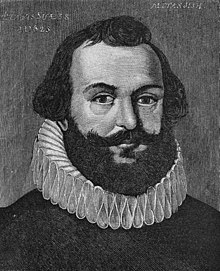Myles Standish
| Myles Standish | |
|---|---|

This portrait, first published in 1885, was alleged to be a 1625 likeness of Standish, although its authenticity has never been proven.
|
|
| Born | c. 1584 Chorley, Lancashire, England |
| Died | October 3, 1656 (aged 72) Duxbury, Massachusetts |
| Allegiance | England Plymouth Colony |
| Rank | Captain |
| Commands held | Plymouth Colony militia |
| Battles/wars |
Eighty Years' War (Netherlands) Wessagusset Colony (Plymouth Colony) |
| Spouse(s) |
Rose Standish Barbara Standish |
| Signature | |
Myles Standish (c. 1584 – October 3, 1656) was an English military officer hired by the Pilgrims as military adviser for Plymouth Colony. He accompanied them on the Mayflower journey and played a leading role in the administration and defense of Plymouth Colony from its inception. On February 17, 1621, the Plymouth Colony militia elected him as its first commander and continued to re-elect him to that position for the remainder of his life.
Standish served as an agent of Plymouth Colony in England, as assistant governor, and as treasurer of the Colony. He was also one of the first settlers and founders of the town of Duxbury, Massachusetts.
A defining characteristic of Standish's military leadership was his proclivity for preemptive action which resulted in at least two attacks (or small skirmishes) on different groups of Native Americans—the Nemasket raid and the conflict at Wessagusset Colony. During these actions, Standish exhibited considerable courage and skill as a soldier, but also demonstrated a brutality that angered Native Americans and disturbed more moderate members of the Colony.
One of Standish's last military actions on behalf of Plymouth Colony was the botched Penobscot expedition in 1635. By the 1640s, he relinquished his role as an active soldier and settled into a quieter life on his Duxbury farm. He was still nominally the commander of the Pilgrim military forces in the growing Colony, although he seems to have preferred to act in an advisory capacity. He died in his home in Duxbury in 1656 at age 72. He supported and defended the Pilgrims' colony for much of his life, though there is no evidence to suggest that he ever joined their church.
Several towns and military installations have been named for Standish, and monuments have been built in his memory. One of the best known depictions of him in popular culture was the 1858 poem The Courtship of Miles Standish by Henry Wadsworth Longfellow. The highly fictionalized story presents him as a timid romantic. It was extremely popular in the 19th century and played a significant role in cementing the Pilgrim story in US culture.
Little is definitively known of Myles Standish's origin and early life. His place of birth has been subject to debate among historians for more than 150 years. At the center of the debate is language in his will, drafted in Plymouth Colony in 1656, regarding his rights of inheritance. Standish wrote:
...
Wikipedia
